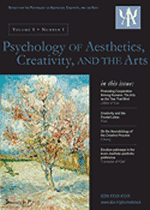
Psychology of Aesthetics Creativity and the Arts
Scope & Guideline
Unlocking the Secrets of Creativity and Aesthetic Appreciation
Introduction
Aims and Scopes
- Interdisciplinary Research on Creativity:
The journal publishes studies that integrate psychological theories with artistic practices, examining how creativity manifests across different domains, including visual arts, music, and literature. - Aesthetic Experience and Perception:
Research often investigates how aesthetic experiences influence emotional responses, appreciation, and engagement with art, employing methodologies such as psychophysiological measures and self-report assessments. - Cognitive and Emotional Processes in Creativity:
The journal emphasizes the cognitive mechanisms underlying creative thinking, including divergent and convergent thinking, and how emotions impact creative output and artistic engagement. - Cultural and Contextual Influences:
Studies frequently explore how cultural background and contextual factors shape aesthetic judgments and creative processes, highlighting the diversity of artistic expression. - Application of Technology in Creativity Assessment:
The journal incorporates innovative approaches, such as machine learning and neuroimaging, to assess and evaluate creativity and aesthetic experiences, advancing methodological frameworks in the field.
Trending and Emerging
- Exploration of Digital and Interactive Art Forms:
There is a growing body of research focusing on digital art, virtual reality, and interactive media, examining how these new forms influence creativity and aesthetic experiences. - Psychological Impacts of Art on Mental Health:
Recent studies increasingly investigate the therapeutic benefits of art engagement, particularly in relation to mental health outcomes, highlighting the role of creativity in well-being. - Cross-Cultural Comparisons in Aesthetic Judgments:
Emerging themes include comparative studies that explore how cultural contexts shape aesthetic preferences and creative expression, reflecting a more global perspective in the research. - Integration of Technology in Creativity Assessment:
The use of advanced technologies, such as machine learning and automated scoring systems, for assessing creativity and artistic engagement is on the rise, enhancing research methodologies. - Interdisciplinary Approaches to Creativity:
There is an increasing trend towards interdisciplinary research that combines insights from psychology, neuroscience, and the arts, fostering a more holistic understanding of creativity and aesthetics.
Declining or Waning
- Overemphasis on Traditional Artistic Genres:
There appears to be a reduced focus on traditional forms of artistic expression, such as classical music and fine arts, as researchers increasingly explore contemporary and digital forms of creativity. - Limited Discussion on Artistic Ethics and Social Responsibility:
Research addressing the ethical implications of artistic practices and the social responsibilities of artists has become less frequent, indicating a potential waning interest in this critical area. - Decline in Studies on Artistic Pedagogy:
There has been a noticeable decrease in publications focused on art education and pedagogy, suggesting a shift towards more empirical and experimental studies rather than educational frameworks. - Reduction in Neuroaesthetic Research:
While neuroaesthetics was once a prominent theme, there seems to be a decline in studies specifically examining the neurological underpinnings of aesthetic experiences, as interest may pivot towards broader interdisciplinary approaches. - Diminished Focus on Historical Contexts of Art:
Research exploring the historical and sociopolitical contexts of art and creativity appears to be declining, possibly overshadowed by more contemporary analyses and empirical studies.
Similar Journals

Religion and the Arts
Fostering Innovative Perspectives on Religion and the ArtsReligion and the Arts is a distinguished scholarly journal published by BRILL, based in the Netherlands, with a dedicated focus on the interdisciplinary exploration of religion and its interplay with various artistic expressions from historical and contemporary perspectives. Established in 1996, this journal serves as a vital platform for researchers, professionals, and students interested in Cultural Studies, History, Religious Studies, and the Visual and Performing Arts. Despite its current classification in the Q4 category across multiple fields, it remains committed to advancing academic discourse and fostering innovative approaches to understanding the complex relationships between spirituality and artistic creation. With its ISSN 1079-9265 and E-ISSN 1568-5292, the journal invites submissions that contribute to enriching this dynamic field, ensuring that a diverse range of voices and perspectives are represented. Although not an Open Access publication, the journal’s content continues to be pivotal for scholarly engagement and is essential reading for those dedicated to the study of art's profound connections with religious traditions.

Neuropsychological Trends
Advancing the Frontiers of NeuropsychologyNeuropsychological Trends is a prominent, open-access journal published by LED EDIZIONI UNIV, based in Italy. Since its inception in 2007, the journal has dedicated itself to advancing research in the fields of neuropsychology and cellular neuroscience, catering specifically to the evolving trends shaping these disciplines. With the ISSN 1970-321X and an E-ISSN of 1970-3201, the journal provides a platform for multidisciplinary dialogue and exploration of neuropsychological phenomena. While ranked in the fourth quartile for both Cellular and Molecular Neuroscience and Neuropsychology and Physiological Psychology categories in 2023, the journal encourages innovative research that aims to enhance understanding and treatment of cognitive and psychological conditions. The convergence of years from 2011 to 2024 marks a significant period for contributions that inform clinical practice and theoretical frameworks. As researchers, professionals, and students engage with cutting-edge studies and reviews, Neuropsychological Trends serves as a vital resource for staying informed and fostering collaboration in the neuropsychological community.
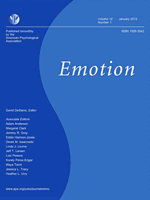
EMOTION
Transforming Perspectives on Emotional HealthEMOTION is a leading peer-reviewed journal published by the American Psychological Association, focusing on the intricate dynamics of human emotions. With its ISSN 1528-3542 and E-ISSN 1931-1516, this esteemed journal has established itself as a pivotal resource in the fields of Psychology and Medicine, proudly ranking in the top quartile (Q1) according to the latest metrics and scoring a remarkable position as #22 out of 216 in the Scopus General Psychology category, placing it in the 90th percentile of its field as of 2023. Spanning from its inception in 2001 to 2024, EMOTION publishes cutting-edge research, theoretical articles, and empirical studies that advance our understanding of emotional processes and their implications for psychological well-being. While EMOTION is not an open-access journal, it remains a crucial platform for researchers, professionals, and students seeking to engage with and contribute to the burgeoning field of emotional psychology.
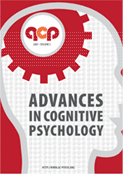
Advances in Cognitive Psychology
Cultivating a Community of Cognitive InnovatorsAdvances in Cognitive Psychology is a premier peer-reviewed journal published by UNIV ECONOMICS & HUMAN SCIENCES WARSAW, dedicated to the exploration of psychological processes underlying cognition. With its open access model implemented since 2005, the journal facilitates wide-ranging dissemination of cutting-edge research across various branches of psychology, including applied, clinical, experimental, and cognitive psychology. Despite its modest standing in terms of impact factor, reflected in its Q3 and Q4 rankings across numerous subfields, it remains an important platform for emerging researchers and seasoned professionals alike, aiming to foster insight into complex mental processes and enhance understanding of behavioral patterns. The journal's commitment to accessibility empowers a diverse community of readers, including students, to engage with innovative studies and reviews, contributing to the collective knowledge within the psychological sciences. Located in Poland, Advances in Cognitive Psychology is open for submissions from worldwide researchers, encouraging a global perspective on cognition and behavior.
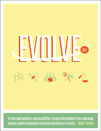
JOURNAL OF CREATIVE BEHAVIOR
Elevating Creative Thought in Education and the ArtsJOURNAL OF CREATIVE BEHAVIOR, published by WILEY, stands as a leading academic platform dedicated to the exploration and dissemination of research within the realms of creativity, education, and the visual and performing arts. With its inception in 1967, this journal has continuously evolved, boasting an impressive scope that invites interdisciplinary approaches to understanding creative processes across various domains. As evidenced by its Q1 ranking in both Education and Visual Arts and Performing Arts, as well as a Q2 ranking in Developmental and Educational Psychology, the journal holds a significant position in its field, publishing high-impact research that often influences educational practices and artistic methodologies alike. Researchers and professionals will benefit from its selective content, which is well-regarded in academic circles, as reflected by its impressive Scopus rankings: it ranks in the 99th percentile in Visual Arts and Performing Arts, and remains a vital resource for students and scholars seeking to delve into the complexities of creative behavior. While the journal is not open access, it continues to serve as an essential repository of knowledge that fosters the development of innovative thinking and pedagogical advancement.
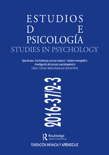
Studies in Psychology
Bridging theory and practice in the realm of psychology.Studies in Psychology, published by SAGE Publications Inc, is a vital journal in the realm of psychology, recognized for its contributions to the field since its inception in 1980. With an ISSN of 0210-9395 and E-ISSN 1579-3699, it serves as a significant platform for researchers and practitioners seeking to disseminate innovative findings and insights. Currently ranked in the Q3 category for psychology (miscellaneous) and holding a Scopus ranking of 153 out of 216 within general psychology, it ensures a balanced representation of theoretical and empirical studies. The journal aims to foster interdisciplinary collaboration and explore a wide array of psychological themes, thereby enhancing understanding and promoting advancements in psychological science. With open access options available, Studies in Psychology offers readers in-depth access to cutting-edge research, thereby solidifying its essential role in academic and applied settings alike.
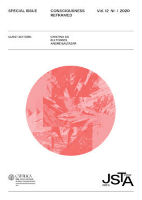
Journal of Science and Technology of the Arts
Advancing Interdisciplinary Dialogue in the Arts.The Journal of Science and Technology of the Arts, published by UNIV CATOLICA PORTUGUESA, is a pioneering open access journal dedicated to the interrelation of the arts and scientific advancements. Since its inception in 2009, it has served as a critical platform for disseminating innovative research across various disciplines, including Visual Arts, Performing Arts, Music, and Conservation. With its ISSN 1646-9798 and E-ISSN 2183-0088, the journal operates from Portugal, attracting a diverse international audience. Although it is currently ranked in Q4 for Arts and Humanities (miscellaneous) and Computer Science Applications, it has achieved notable Q3 rankings in Conservation, Music, and Visual Arts and Performing Arts as of 2023. The journal's impact is reflected in its Scopus rankings, which place it in the midst of its peers, showcasing its growing influence. Through its commitment to fostering interdisciplinary dialogue, the Journal of Science and Technology of the Arts is essential for researchers, professionals, and students interested in the innovative integration of arts and technology.
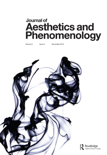
Journal of Aesthetics and Phenomenology
Fostering Dialogue on Aesthetics and PhenomenologyJournal of Aesthetics and Phenomenology, published by Routledge Journals, Taylor & Francis Ltd, is a significant resource within the field of philosophy, focusing specifically on the intricate relationship between aesthetics and phenomology. Since its inception in 2014, this journal has fostered critical dialogue among scholars, highlighting contemporary debates and innovative theoretical perspectives. With an ISSN of 2053-9320 and E-ISSN of 2053-9339, the journal offers a platform for researchers to contribute original articles that delve into the complexities of human experience and artistic expression. Although currently categorized in Q3 in Philosophy and positioned at Rank #630/806 in the Scopus rankings, it consistently attracts submissions from promising scholars eager to engage with its themes. While not an open access journal, it provides valuable insights into aesthetic theory and philosophy, appealing to students, researchers, and professionals alike, who are keen on exploring the nuances of these interrelated fields.

Art & Perception
Advancing Understanding of Visual Arts and PsychologyArt & Perception, published by BRILL, stands as a pivotal journal in the exploration of visual arts and the psychology of perception. With a robust ISSN of 2213-4905 and E-ISSN of 2213-4913, this journal has established itself as an indispensable resource for researchers, professionals, and students in the fields of Applied Psychology, History, and Visual Arts. As of 2023, it enjoys impressive rankings in its categories, with a Q3 status in Applied Psychology and a Q1 status in both History and Visual Arts, reflecting its scholarly impact. The journal operates from its base in Leiden, Netherlands, and spans an impressive coverage from 2013 to 2024. While it does not currently offer open access, its commitment to disseminating valuable research makes it an essential read for those seeking to deepen their understanding of art perception and its psychological underpinnings. With a Scopus rank of #39 out of 667 in Arts and Humanities, and a remarkable 94th percentile, Art & Perception continues to shape discourse and innovation at the intersection of art and psychology.
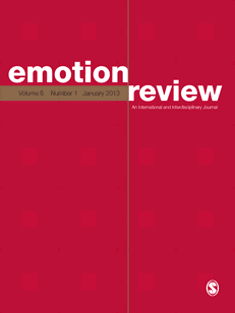
Emotion Review
Exploring the Depths of EmotionEmotion Review, published by SAGE Publications Inc, is a leading international journal that focuses on the multidisciplinary examination of emotional processes across various fields. Launched in 2009 and maintaining a strong presence in the UK, this journal has rapidly ascended to be classified in the Q1 quartile across several categories, including Arts and Humanities (miscellaneous), Experimental and Cognitive Psychology, and Social Psychology. With its outstanding Scopus rankings—evident from its 93rd percentile in Arts and Humanities and 88th percentile in Psychological disciplines—Emotion Review plays a crucial role in advancing the understanding of emotional phenomena, offering a platform for innovative research and theoretical developments. While this journal does not provide open access options, it remains a vital resource for researchers, professionals, and students eager to explore the complexities of emotions and their impact on human behavior, making it an essential addition to any academic library.